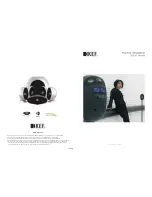
AIR N ARC
®
150 SERIES
SECTION 1: SAFETY
090043-OP_r0 (MARCH-2015)
PAGE - 5
VANAIR MANUFACTURING, INC.
(800) 526-8817 • www.vanair.com
Install cylinders in an upright position by
securing to a stationary support or cylinder
rack to prevent falling or tipping.
Keep cylinders away from any welding or
other electrical circuits.
Never drape a welding torch over a gas
cylinder.
Never allow a welding electrode to touch any
cylinder.
Never weld on a pressurized cylinder—
explosion will result.
Use only correct shielding gas cylinders,
regulators, hoses, and fittings designed for
the specific application; maintain them and
associated parts in good condition.
Turn face away from valve outlet when
opening cylinder valve.
Keep protective cap in place over valve
except when cylinder is in use or connected
for use.
Use the right equipment, correct procedures,
and sufficient number of persons to lift and
move cylinders.
Read and follow instructions on compressed
gas cylinders, associated equipment, and
Compressed Gas Association (CGA)
publication P-1 listed in Safety Standards.
1.5 ENGINE HAZARDS
1.5.1
BATTERY EXPLOSION CAN
BLIND
Always wear a face shield,
rubber gloves, and
protective clothing when
working on a battery.
Stop engine before
disconnecting or connecting
battery cables or servicing battery.
Do not allow tools to cause sparks when
working on a battery.
Do not use weld mode to charge batteries or
jump start vehicles.
Observe correct polarity (+ and
−
) on
batteries.
Disconnect negative (
−
) cable first and
connect it last.
1.5.2
FUEL CAN CAUSE FIRE OR
EXPLOSION
Stop engine and let it cool
off before checking or
adding fuel.
Always keep nozzle in
contact with tank when
fueling.
Do not add fuel while smoking or if unit is
near any sparks or open flames.
Do not overfill tank—allow room for fuel to
expand.
Do not spill fuel. If fuel is spilled, clean up
before starting engine.
Dispose of rags in a fireproof container.
1.5.3
MOVING PARTS CAN CAUSE
INJURY
Keep away from fans, belts,
and rotors. Keep all doors,
panels, covers, and guards
closed and securely in
place.
Stop engine before installing
or connecting unit.
Have only qualified people remove doors,
panels, covers, or guards for maintenance
and troubleshooting as necessary.
Disconnect negative (
−
) battery cable from
battery to prevent accidental starting during
servicing.
Keep hands, hair, loose clothing, and tools
away from moving parts.
Reinstall doors, panels, covers, or guards
when servicing is finished and before starting
engine.
















































